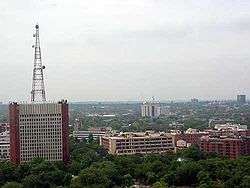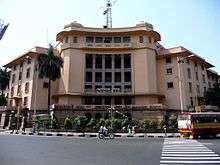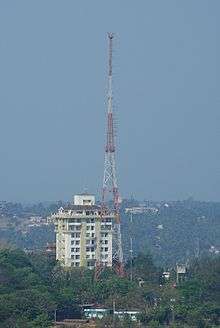All India Radio
 | |
| Type | Government Organisation |
|---|---|
| Country | India |
| Availability | National |
| Motto | Bahujan Hitaya Bahujan Sukhaya[1] |
| Headquarters | Sansad Marg, New Delhi - 110001, India, |
| Owner | Prasar Bharati |
Launch date | 1930 |
| Webcast | GIR.fm-Delhi, GIR.fm-Kolkata |
Official website | www.allindiaradio.org, www.newsonair.nic.in |

All India Radio (AIR), officially known since 1956 as Ākāshvāṇī (literally, "Voice from the sky"), is the national public radio broadcaster of India and a division of Prasar Bharati. Established in 1930,[2] it is the sister service of Prasar Bharati's Doordarshan, the national public television broadcaster. AIR has covered more than 99% of the Indian Population as per the latest information given by Minister of Information and Broadcast. All India Radio is one of the largest radio networks in the world. Its headquarters is at the Akashvani Bhavan in New Delhi. Akashvani Bhavan houses the Drama Section, the FM Section and the National Service. Akashvani Bhavan hosts Doordarshan Kendra (Delhi).
Etymology
Ākāśavāni (आकाशवाणी) is a Sanskrit word meaning "celestial announcement," or "voice from the sky/heaven". In Hindu, Jain and Buddhist mythology, Akashvanis often featured in stories as a medium of communication from the heavens to mankind.
"Akashvani" was first used in the context of radio by M. V. Gopalaswamy after setting up the nation’s first private radio station in his residence, "Vittal Vihar" (about 200 yards from AIR’s current location in Mysore) in 1936.[3] Akashvani seemed to be an appropriate name for a radio broadcaster and was later adopted as All India Radio's on-air name in 1956.
History
During the British Raj, broadcasting began in July 1923 with programmes by the Bombay Presidency Radio Club and other radio clubs. According to an agreement of 23 July 1927, the private Indian Broadcasting Company LTD (IBC) was authorized to operate two radio stations; the Bombay station began on 23 July 1927, and the Calcutta station followed on 26 August 1927. However, on 1 March 1930, the company went into liquidation. The government took over the broadcasting facilities, beginning the Indian State Broadcasting Service (ISBS) on 1 April 1930 on an experimental basis for two years, and then permanently in May 1932. On 8 June 1936, the ISBS was renamed All India Radio.[2]
On 1 October 1939, the External Service began with a broadcast in Pushtu; it was intended to counter radio propaganda from Germany directed to Afghanistan, Iran and the Arab nations. When India became independent in 1947, the AIR network had only six stations (in Delhi, Bombay, Calcutta, Madras, Lucknow, and Tiruchirappalli); three radio stations at Lahore, Peshawar and Karachi fell in the share of Pakistan. the total number of radio sets at that time was about 275,000 in India. On 3 October 1957, the Vividh Bharati Service was launched, to compete with Radio Ceylon. Television broadcasting began in Delhi in 1959 as part of AIR, but was split off from the radio network as Doordarshan on 1 April 1976.[4] FM broadcasting began on 23 July 1977 in Chennai, and was expanded during the 1990s.[5]
Domestic services

AIR has many services in a number of languages, each serving different regions across India.
Vividh Bharati
Vividh Bharati is one of the best-known services of AIR. Its name roughly translates as "Diverse Indian", and it is also known as the Commercial Broadcasting Service (CBS). It is the commercially most accessible of the AIR networks and is popular in Mumbai and other large cities. Vividh Bharati offers a wide range of programmes including news, film music and comedy programs. It operates on different mediumwave-band frequencies for each city.
Some programs broadcast on Vividh Bharati are:
- Hawa-mahal: Radio plays based on novels and plays
- Santogen ki mehfil: Comedy
Baluchi Programme on AIR
AIR is planning on revamping the programme in Baluchi language, sources claim.[6]
Other services include
- Primary Channel
- National Channel[7]
Regional services
The headquarters of the Regional Deputy Directors General are located at Delhi and Chandigarh (NR), Lucknow and Bhopal (CR), Guwahati (NER), Kolkata (ER), Mumbai and Ahmedabad (WR), Chennai and Bangalore (SR).[8] All frequencies are in kHz, unless otherwise noted.
| City | Frequency | City | Frequency | City | Frequency | |
|---|---|---|---|---|---|---|
| Agra | 1530 | Ajmer | 603 | Allahabad | 1026 | |
| Almora | 999 | Barmer | 1458 | Bikaner | 1395 | |
| chairhara(budgam) | 1485 | srinagar | 819 | srinagar | 666 | |
| Delhi C (Vividh Bharti) (विविध भारती) | 1368 | Delhi D (Yuv-vani) (युव वाणी) | 1017 | Delhi (National Channel) | 1215 | |
| Diskit | 1602 | Drass | 1485 | Gorakhpur | 909 | |
| Jaipur A | 1476 | Jalandhar A | 837 | Jalandhar B | 702 | |
| Jammu A | 990 | Jodhpur A | 531 | Kalpa (Kinnaur) | 1584 | |
| Kargil A | 684 | Kargil B | 1584 | Khalsi | 1485 | |
| Kota | 1413 | Kupwara | 1350 | Leh | 1053 | |
| Lucknow A | 747 | Lucknow C | 1278 | Mathura | 1584 | |
| Najibabad | 954 | Naushera | 1089 | Nyoma | 1485 | |
| Padam | 1589 | Pauri | 1602 | Pithoragarh | 1602 | |
| Rampur | 895 | Rohtak | 1143 | Shimla | 774 | |
| budgam | 1116 | budgamA | 1224 | srinagar C | 918 | |
| Tiesuru | 1602 | Udaipur | 1125 | Uttarkashi | 1602 | |
| Varanasi A | 1242 | Sawai Madhopur | 101.5 |
| City | Frequency | City | Frequency |
|---|---|---|---|
| Agartala | 1269 | Guwahati A | 729 |
| Shillong | 864 | Imphal | 822 |
| City | Frequency | City | Frequency |
|---|---|---|---|
| Bhagalpur | 1458, 1206 | Chinsurah (Kolkata A, 1 MW) | 594 & 1134 |
| Cuttack A | 972 | Darbhanga | 1296 |
| Jamshedpur | 1544 | Kolkata A | 657 |
| Kolkata B | 1008 | Kolkata C (Vividh Bharati) | 1323 |
| Patna A | 621 | Ranchi A | 549 |
| Muzaffarpur A | 100.1 MHz | Muzaffarpur B | 106.4 MHz |
| Kolkata (FM Rainbow) | 107 | Kolkata (FM Gold) | 100.2 |
| City | Frequency | City | Frequency |
|---|---|---|---|
| Ahmedabad A | 846 | Aurangabad | 1521 |
| Bhopal A | 1593 | Chhindwara | 102.2 MHz |
| Chhatarpur | 675 | Gwalior | 1386 |
| Indore A | 648 | Jalgaon | 963 |
| Mumbai A | 1044 | Mumbai B (Asmita Marathi Programme) | 558 |
| Mumbai C (Vividh Bharati) | 1188 | Nagpur A | 585 |
| Nagpur B (National Channel, 1 MW) | 1566 | Panaji A | 1287 |
| Panaji B (Vividh Bharati) | 828 | Pune A | 792 |
| Rajkot A | 810 | Ratnagiri | 1143 |
| Solapur | 1602 | Sangli | 1251 |
| City | Frequency | City | Frequency | ||
|---|---|---|---|---|---|
| Adilabad | 1485 | Bangalore A | 612 | ||
| Chennai A | 720 kHz | Chennai C (Vividh Bharati) | 783 kHz | ||
| Chennai B | 1017 kHz | ||||
| Coimbatore | 999 kHz | Gulbarga | 1107 | ||
| Hyderabad A | 738 | Hyderabad B | 1377 | ||
| Kozhikode A | 684 | Madurai | 1269 kHz | ||
| Nagercoil | 101 MHz | Udhagamandalam | 1602 kHz | ||
| Port Blair | 684 | Thiruvananthapuram A | 1161 | ||
| Thiruvananthapuram | 101.9 MHz | Thrissur A | 630 | ||
| Tiruchirapalli A | 936 kHz | Tirunelveli | 1197 kHz | ||
| Vijayawada A | 837 | Visakhapatnam | Tirupati A | 1075 | |
| Gautam | 456 | Pondicherry | 1215 |
| Parbhani A || 102.0
External services
The external services of All India Radio broadcast in 27 languages to countries outside India—primarily via high-power shortwave band broadcasts, although medium wave is also used to reach neighbouring countries. In addition to broadcasts targeted at specific countries by language, there is a General Overseas Service broadcasting in English with 8¼ hours of programming each day aimed at a general international audience. The external broadcasts were begun on 1 October 1939 by the British government to counter the propaganda of the Nazis directed at the Afghan people. The first broadcasts were in Pushto, beamed to Afghanistan and the North-West Frontier Province. Soon broadcasts began in other languages including Dari, Persian, Arabic, English, Burmese, Japanese, Chinese, Malay and French. The external services broadcast in 16 foreign and 11 Indian languages, with a total program output of 70¼ hours per day on medium- and shortwave.
| Location | Number of transmitters | kW | Frequency | DRM ! |
|---|---|---|---|---|
| Aligarh (HPT) | 4 | 250 | ||
| Bengaluru (SPT) | 6 | 500 | 100 kW | |
| Chennai (Madras) | 1 | 100 | 720 kHz | MW |
| Gorakhpur | 1 | 50 | ||
| Guwahati | 1 | 50 | ||
| Jalandhar (Goraya) | 1 | 300 | 702 kHz | MW |
| Khampur-Delhi (HPT) | 7 | 250 | ||
| Khampur-Delhi (SPT) | 2 | 500 | ||
| Kingsway-Delhi | 3 | 50 | ||
| Kingsway-Delhi | 2 | 100 | ||
| Kolkata-Chinsurah/Mogra (SPT) | 1 | 1000 | 1134 kHz and 594 kHz(Kolkata - A) | 1142 KHZMW |
| Mumbai (Malad) | 1 | 100 | ||
| Nagpur (SPT) | 1 | 1000 | 1566 kHz | MW |
| Panaji (HPT) | 2 | 250 | ||
| Rajkot (SPT) | 1 | 1000 | 1071 kHz AIR URDU | 1080 kHz(2 MegaWatt)Vividha Bharti |
| Tuticorin | 1 | 200 | 1053 kHz | MW |
Two high powered FM stations of All India Radio are under installation in Amritsar and Fazilka in Punjab to supplement the programs put out from transmitters operating from Jalandhar, New Delhi, Chandigarh and Mumbai and to improve the broadcast services during disturbed weather conditions in the border regions of Punjab.
Today, the External Services Division of All India Radio broadcasts daily in 57 transmissions with almost 72 hours covering over 108 countries in 27 languages, out of which 15 are foreign and 12 Indian. The foreign languages are Arabic, Baluchi, Burmese, Chinese, Dari, French, Indonesian, Persian, Pushtu, Russian, Sinhala, Swahili, Thai, Tibetan and English (General Overseas Service). The Indian languages are Bengali, Gujarati, Marathi, Kokani, Kashmiri, Hindi, Kannada, Malayalam, Nepali, Punjabi, Saraiki, Sindhi, Tamil, Telugu and Urdu.
The longest daily broadcast is the Urdu Service to Pakistan, around the clock on DTH and on short- and mediumwave for 12¼ hrs. The English-language General Overseas Service are broadcast 8¼ hours daily. During Hajj, there are special broadcasts beamed to Saudi Arabia in Urdu. The external services of AIR are also broadcast to Europe in DRM (Digital Radio Mondiale) on 9950 kHz between 1745-2230 UTC.
The transmissions are broadcast by high-power transmitters located at Aligarh, Bengaluru, Chennai, Delhi, Gorakhpur, Guwahati, Mumbai and Panaji on shortwave and from Jalandhar, Kolkata, Nagpur, Rajkot and Tuticorin on mediumwave. Soon All India Radio Amritsar will start a booster service on FM band too. Some of these transmitters are 1000 kW (1 MW) or 500 kW. Programs are beamed to different parts of the world except the Americas and received in very good Reception Quality in the Target areas. In each language service, the program consists of news, commentary, a press review, talks on matters of general or cultural interest, feature programmes, documentaries and music from India and the target region. Most programs originate at New Broadcasting House on Parliament Street in New Delhi, with a few originating at SPT Bengaluru, Chennai, Hyderabad, Jalandhar, Kolkata, HPT Malad Mumbai, Thiruvananthapuram and Tuticorin.
The External Services Division of AIR is a link between India and rest of the world, especially in countries with Indian emigrants and people of Indian origin. It broadcasts the Indian point of view on matters of national and international importance, and demonstrates the Indian way of life through its programs. QSL cards (which are sought-after by international radio hobbyists) are issued to radio hobbyists by AIR in New Delhi for reception reports of their broadcasts.
Other services
Digital Radio Mondiale (DRM)
Details of the transmissions and frequencies are as follows: 0130 - 0230 UTC on 11715 kHz Nepali (Nepal) 0315-0415 UTC on 15185 kHz Hindi, (E.Africa, Mauritius) 0415-0430 UTC on 15185 kHz Gujarati, (E.Africa, Mauritius) 0430-0530 UTC on 15185 kHz Hindi(E.Africa, Mauritius) 1300 - 1500 UTC on 15050 kHz Sinhala (Sri Lanka) 1615-1715 UTC on 15140 kHz Russian (E. Europe) 2245-0045 UTC on 11645 GOS-I English (NE Asia)
Above transmissions are in addition to following existing DRM txn's: 0900-1200 on 6100 Vividh Bharati, DRM NVIS 1745-1945 UTC on 9950 English W. Europe) 1945-2045 UTC on 9950 Hindi (W. Europe) 2045-2230 UTC on 9950 English (W. Europe)
News-on-phone service
All India Radio launched news-on-phone service on 25 February 1998 in New Delhi; it now has service in Chennai, Mumbai, Hyderabad, Indore, Patna and Bangalore. The service is accessible through STD, ISD and local calls. There are plans to establish the service in 11 more cities: Ahmedabad, Bhopal, Guwahati, Gwalior, Jabalpur, Jaipur, Kolkata, Lucknow, Ranchi, Shimla and Thiruvananthapuram. English and Hindi hourly news bulletins may be heard live.[9] News in MP3 format may be directly played from the site, and filenames are time-stamped. AIR news bulletins are available in nine regional languages (Tamil, Kannada, Gujarati, Bengali, Marathi, North East, Punjabi, Telugu and Urdu).
Direct-to-home service
Direct-to-home service is the one in which a large number of channels are digitally compressed, encrypted, uplinked and beamed down over a territory from a very high power satellite. The DTH signals can be received directly at homes with the help of a small sized dish receive unit containing a Dish Antenna installed at the building’s roof-top or on the wall facing clear south and one indoor.[10] DTH service is offered on 21 channels via Insat.
Documentaries
There is a long tradition of documentary features on AIR. There is great interest in radio documentaries, particularly in countries like India, Iran, South Korea and Malaysia. The doyen of English Features was Melville De Mellow and of Hindi Features was Shiv Sagar Mishra. This format has been revived because of its flexibility, cost-cutting capacity, messaging potential and creative potential with producers employed with AIR, all across the nation.
Central Drama Unit
AIR's Central Drama Unit is responsible for the national broadcast of plays. Plays produced by the CDU are translated and produced by regional stations. Since its inception in the 1960s the unit has produced more than 1,500 plays, and the CDU is a repository of old scripts and productions. The National Programme of Plays is broadcast by the CDU of AIR the fourth Thursday of each month at 9.30 pm. On the National Programme of Plays, the same play is produced in 22 Indian languages and broadcast at the same time by all regional and national network stations. The CDU also produces Chain Plays, half-hour dramas broadcast in succession by a chain of stations.
Social Media Cell
News Service Division's Social Media Cell is responsible for providing AIR news on new media platforms viz. websites, Twitter, Facebook and SMS. Social Media Cell was established on 20 May 2013.
See also
- External program hours - Comparison with some other external radio broadcasters
- Vividh Bharati
- AIR FM Rainbow
- AIR FM Gold
- 106.4 FM Radio Gold
- Telugu Radio
- Radio Kashmir
- Telecommunications in India
References
- ↑ "Mission Of AIR".
- 1 2 "Milestones of AIR (official website)". All India Radio. Retrieved 13 January 2013.
- ↑ "Mysore Akashavani is now 75 years old". Business Standard.
- ↑ "AIR Manual, Chapter 1: History of All India Radio" (PDF). Archived from the original (PDF) on 17 September 2010.
- ↑ "Milestones of AIR". All India Radio. Archived from the original on 12 June 2010.
- ↑ http://www.business-standard.com/article/news-ians/all-india-radio-to-revamp-baluchi-language-programme-116083101302_1.html
- ↑ "National Channel". Archived from the original on 15 October 2011. Retrieved 2 May 2014.
- ↑ "All India Radio". Know India. Archived from the original on 3 September 2011. Retrieved 15 October 2011.
- ↑ "Prasar Bharati". Retrieved 17 October 2011.
- ↑ "DD Free Dish (DTH)". www.ddindia.gov.in. Retrieved 2016-07-21.
External links
| Wikimedia Commons has media related to All India Radio. |
| Look up Akashvani in Wiktionary, the free dictionary. |
- All India Radio Official web-site
- All India Radio Commercial Broadcasting Service Vividh Bharati On Line
- All India Radio Commercial Broadcasting Service Vividh Bharati On Line
- All India Radio General Overseas Service / External Services Division 1-4 On Line
- Know India: Radio
- All India Radio (AIR) Station Frequencies (National/International)
- Children's wing of All India Radio
- External Service of All India Radio
